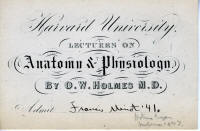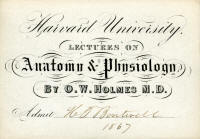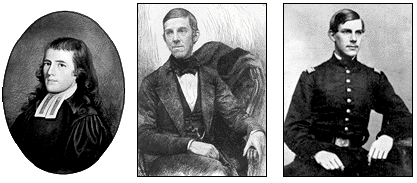Oliver
Wendell Holmes, Sr. M.D.


Oliver Wendell
Holmes, M.D. signed, Harvard University, Anatomy & Physiology,
1846, 1867
Click image to enlarge
Go to lecture card display
Oliver Wendell Holmes Sr. (August 29, 1809 –
October 7, 1894) was an American physician, professor, lecturer and
author. Regarded by his peers as one of the best poets of the 19th
century, he is considered a member of the Fireside Poets. His most
famous prose works are the "Breakfast-Table" series, which began with
The Autocrat of the Breakfast-Table (1858). He is also recognized as an
important medical reformer.
Born in Cambridge, Massachusetts, Holmes was educated at Phillips
Academy and Harvard College. After graduating from Harvard in 1829, he
briefly studied law before turning to the medical profession. He began
writing poetry at an early age; one of his most famous works, "Old
Ironsides", was published in 1830. Following training at the prestigious
medical schools of Paris, Holmes was granted his M.D. from Harvard
Medical School in 1836. He taught at Dartmouth Medical School before
returning to teach at Harvard and, for a time, served as dean there.
During his long professorship, he became an advocate for various medical
reforms and notably posited the controversial idea that doctors were
capable of carrying puerperal fever from patient to patient. Holmes
retired from Harvard in 1882 and continued writing poetry, novels and
essays until his death in 1894.
Surrounded by Boston's literary elite—which included friends such as
Ralph Waldo Emerson, Henry Wadsworth Longfellow, and James Russell
Lowell—Holmes made an indelible imprint on the 19th century literary
world. Many of his works were published in The Atlantic Monthly, a
magazine that he named. For his literary achievements and other
accomplishments, he was awarded numerous honorary degrees from
universities around the world. Holmes's writing often commemorated his
native Boston area, and much of it was meant to be humorous or
conversational. Some of his medical writings, notably his essay
regarding the contagiousness of puerperal fever, were considered
innovative for their time. He was often called upon to issue occasional
poetry, or poems written specifically for an event, including many
occasions at Harvard. Holmes also popularized several terms, including
"Boston Brahmin" and anesthesia.
Having given up on the study of law, Holmes switched to medicine. After
leaving his childhood home in Cambridge during the autumn of 1830, he
moved into a boardinghouse in Boston to attend the city's medical
college. At that time, students studied only five subjects: medicine,
anatomy and surgery, obstetrics, chemistry and materia medica.[33]
Holmes became a student of James Jackson, a physician and the father of
a friend, and worked part-time as a chemist in the hospital dispensary.
Dismayed by the "painful and repulsive aspects" of primitive medical
treatment of the time—which included practices such as bloodletting and
blistering—Holmes responded favorably to his mentor's teachings, which
emphasized close observation of the patient and humane approaches.[34]
Despite his lack of free time, he was able to continue writing. He wrote
two essays during this time which detailed life as seen from his
boardinghouse's breakfast table. These essays, which would evolve into
one of Holmes's most popular works, were published in November 1831 and
February 1832 in the New England Magazine under the title "The Autocrat
of the Breakfast-Table".[35]
In 1833, Holmes traveled to Paris to further his medical studies. Recent
and radical reorganization of the city's hospital system had made
medical training there highly advanced for the time.[36] At twenty-three
years old, Holmes was one of the first Americans trained in the new
"clinical" method being advanced at the famed École de Médecine.[37]
Since the lectures were taught entirely in French, he engaged a private
language tutor. Although far from home, he stayed connected to his
family and friends through letters and visitors—Ralph Waldo Emerson, for
example, visited one day—he quickly acclimated to his new surroundings.
While writing to his father, he stated, "I love to talk French, to eat
French, to drink French every now and then."[38]
At the hospital of La Pitié, he studied under internal pathologist
Pierre Charles Alexandre Louis, who demonstrated the ineffectiveness of
bloodletting, which had been a mainstay of medical practice since
antiquity.[39][40] Dr. Louis was one of the fathers of the méthode
expectante, a therapeutic doctrine that states the physician's role is
to do everything possible to aid nature in the process of disease
recovery, and to do nothing to hinder this natural process.[41] Upon his
return to Boston, Holmes became one of the country's leading proponents
of the méthode expectante. Holmes was awarded his M.D. from Harvard in
1836; he wrote his dissertation on acute pericarditis.[42] His first
collection of poetry was published later that year, but Holmes, ready to
begin his medical career, wrote it off as a one-time event. In the
book's introduction, he mused: "Already engaged in other duties, it has
been with some effort that I have found time to adjust my own mantle;
and I now willingly retire to more quiet labors, which, if less
exciting, are more certain to be acknowledged as useful and received
with gratitude".[43]
After graduation, Holmes quickly became a fixture in the local medical
scene by joining the Massachusetts Medical Society, the Boston Medical
Society, and the Boston Society for Medical Improvement—an organization
composed of young, Paris-trained doctors.[44] He also gained a greater
reputation after winning Harvard Medical School's prestigious Boylston
Prize, for which he submitted a paper on the benefits of using the
stethoscope, a device with which many American doctors were not
familiar.[45]
In 1837, Holmes was appointed to the Boston Dispensary, where he was
shocked by the poor hygienic conditions.[46] That year he competed for
and won both of the Boylston essay prizes. Wishing to concentrate on
research and teaching, he, along with three of his peers, established
the Tremont Medical School—which would later merge with Harvard Medical
School[47]—above an apothecary shop at 35 Tremont Row in Boston. There,
he lectured on pathology, taught the use of microscopes, and supervised
dissections of cadavers.[48] He often criticized traditional medical
practices and once quipped that if all contemporary medicine was tossed
into the sea "it would be all the better for mankind—and all the worse
for the fishes".[49] For the next ten years, he maintained a small and
irregular private medical practice, but spent much of his time teaching.
He served on the faculty of Dartmouth Medical School from 1838 to
1840,[50] where he was appointed professor of anatomy and physiology.
For fourteen weeks each fall, during these years, he traveled to
Hanover, New Hampshire, to lecture.[51]
On June 15, 1840, Holmes married Amelia Lee Jackson at King's Chapel in
Boston.[52] She was the daughter of the Hon. Charles Jackson, formerly
Associate Justice of the Massachusetts Supreme Judicial Court, and the
niece of James Jackson, the pysician with whom Holmes had studied.[53]
Judge Jackson gave the couple a house at 8 Montgomery Place, which would
be their home for eighteen years. They had three children: Civil War
hero and American jurist Oliver Wendell Holmes, Jr. (1841–1935), Amelia
Jackson Holmes (1843–1889), and Edward Jackson Holmes (1846–1884).[54]
After Holmes resigned his professorship at Dartmouth, he composed a
series of three lectures dedicated to exposing medical fallacies, or
"quackeries". Adopting a more serious tone than his previous lectures,
he took great pains to reveal the false reasoning and misrepresentation
of evidence that marked subjects such as "Astrology and Alchemy", his
first lecture, and "Medical Delusions of the Past", his second.[55] He
deemed homeopathy, the subject of his third lecture, "the pretended
science" that was a "mingled mass of perverse ingenuity, of tinsel
erudition, of imbecile credulity, and of artful misrepresentation, too
often mingled in practice".[56] In 1842, he published the essay
"Homeopathy and Its Kindred Delusions"[57] in which he again denounced
the practice.
Charles D. Meigs, an opponent of Holmes's theory regarding the
contagious nature of puerperal fever, wrote that doctors are gentlemen,
and "gentlemen's hands are clean".[58]In 1843, Holmes published "The
Contagiousness of Puerperal Fever" in the short-lived publication New
England Quarterly Journal of Medicine and Surgery. The essay
argued—contrary to popular belief at the time, which predated germ
theory of disease—that the cause of puerperal fever, a deadly infection
contracted by women during or shortly after childbirth, stems from
patient to patient contact via their physicians.[59] Holmes gathered a
large collection of evidence for this theory, including stories of
doctors who had become ill and died after performing autopsies on
patients who had likewise been infected.[60] In concluding his case, he
insisted that a physician in whose practice even one case of puerperal
fever had occurred, had a moral obligation to purify his instruments,
burn the clothing he had worn while assisting in the fatal delivery, and
cease obstetric practice for a period of at least six months.[61] A few
years later, Ignaz Semmelweis would reach similar conclusions in Vienna,
where his introduction of prophylaxis (handwashing in chlorine solution
before assisting at delivery) would considerably lower the puerperal
mortality rate.
Though it largely escaped notice when first published, Holmes eventually
came under attack by two distinguished professors of obstetrics—Hugh L.
Hodge and Charles D. Meigs—who adamantly denied his theory of
contagion.[62] In 1855, Holmes chose to republish the essay in the form
of a pamphlet under the new title Puerperal Fever as a Private
Pestilence. In a new introduction, in which Holmes directly addressed
his opponents, he wrote: "I had rather rescue one mother from being
poisoned by her attendant, than claim to have saved forty out of fifty
patients to whom I had carried the disease."[63] He added, "I beg to be
heard in behalf of the women whose lives are at stake, until some
stronger voice shall plead for them."[64] The then controversial work is
now considered a landmark in germ theory of disease.[27]
In 1846, Holmes coined the word "anesthesia". In a letter to dentist
William T. G. Morton, the first practitioner to publicly demonstrate the
use of ether during surgery, he wrote: "Everybody wants to have a hand
in a great discovery. All I will do is to give a hint or two as to
names—or the name—to be applied to the state produced and the agent. The
state should, I think be called 'Anaesthesia.' This signifies
insensibility—more particularly ... to objects of touch."[65] Holmes
predicted his new term "will be repeated by the tongues of every
civilized race of mankind."[66]
Teaching and lecturing
In 1847, Holmes was hired as Parkman Professor of Anatomy and Physiology
at Harvard Medical School, where served as dean until 1853 and taught
until 1882.[67] Soon after his appointment, Holmes was criticized by the
all-male student body for considering granting admission to a woman
named Harriet Kezia Hunt.[68] Facing opposition not only from student
but also from university overseers and other faculty members, she was
asked to withdraw her application.[69] Harvard Medical School would not
admit a woman until 1945.[70] Holmes's training in Paris led him to
teach his students the importance of anatomico-pathological basis of
disease, and that "no doctrine of prayer or special providence is to be
his excuse for not looking straight at secondary causes."[71] Students
were fond of Holmes, who they referred to as "Uncle Oliver". One
teaching assistant recalled: "He enters [the classroom] and is greeted
by a mighty shout and stamp of applause. Then silence, and there begins
a charming hour of description, analysis, anecdote, harmless pun, which
clothes the dry bones with poetic imagery, enlivens a hard and fatiguing
day with humor, and brightens to the tired listener the details for
difficult though interesting study."[66]
Amelia Holmes inherited $2,000 in 1848, and she and her husband used the
money to build a summer house in Pittsfield, Massachusetts. Beginning in
July 1849, the family spent "seven blessed summers" there.[72] Having
recently given up his private medical practice, Holmes was able to
socialize with other literary figures who spent time in The Berkshires;
in August 1850, for example, Holmes spent time with Evert Augustus
Duyckinck, Cornelius Mathews, Herman Melville, James Thomas Fields and
Nathaniel Hawthorne.[73] Holmes enjoyed measuring the circumference of
trees on his property and kept track of the data, writing that he had "a
most intense, passionate fondness for trees in general, and have had
several romantic attachments to certain trees in particular".[74] The
high cost of maintaining their home in Pittsfield caused the Holmes
family to sell it in May 1856.[72]
While serving as dean in 1850, Holmes became a witness for both the
defense and prosecution during the notorious Parkman-Webster murder
case.[75] Both George Parkman (the victim), a local physician and
wealthy benefactor, and John Webster (the assailant) were graduates of
Harvard, and Webster was professor of chemistry at the Medical School
during the time of the highly publicized murder. He was convicted and
hanged. Holmes dedicated his November 1850 introductory lecture at the
Medical School to Parkman's memory.[72]
While dean, Holmes attempted to admit the first African-Americans and
the first female to the Harvard Medical School.
The same year, Holmes was
approached by Martin Delany, an African-American man who had worked with
Frederick Douglass. The 38-year-old requested admission to Harvard after
having been previously rejected by four schools despite impressive
credentials.[76] In a controversial move, Holmes admitted Delany and two
other black men to the Medical School. Their admission sparked a student
statement, which read: "Resolved That we have no objection to the
education and evaluation of blacks but do decidedly remonstrate against
their presence in College with us."[77] Sixty students signed the
resolution, although 48 students signed another resolution which noted
it would be "a far greater evil, if, in the present state of public
feeling, a medical college in Boston could refuse to this unfortunate
class any privileges of education, which it is in the power of the
profession to bestow".[68] In response, Holmes told the black students
they would not be able to continue after that semester.[77] A faculty
meeting directed Holmes to write that "the intermixing of races is
distasteful to a large portion of the class, & injurious to the
interests of the school".[68] Despite his support of education for
blacks, he was not an abolitionist; against what he considered the
abolitionists' habit of using "every form of language calculated to
inflame", he felt that the movement was going too far.[78] This lack of
support dismayed friends like James Russell Lowell, who once told Holmes
he should be more outspoken against slavery. Holmes calmly responded,
"Let me try to improve and please my fellowmen after my own fashion at
present."[79] Nonetheless, Holmes believed that slavery could be ended
peacefully and legally.[80]
Holmes lectured extensively from 1851 to 1856 on subjects such as
"Medical Science as It Is or Has Been", "Lectures and Lecturing", and
"English Poets of the Nineteenth Century".[81] Traveling throughout New
England, he received anywhere from $40 to $100 per lecture,[82] but he
also published a great deal during this time, and the British edition of
his Poems sold well abroad. As social attitudes began to change,
however, Holmes often found himself publicly at odds with those he
called the "moral bullies"; because of mounting criticisms from the
press regarding Holmes's vocal anti-abolitionism, as well as his dislike
of the growing temperance movement, he chose to discontinue his
lecturing and return home.[83]
About 1860, Holmes invented the "American stereoscope", a 19th century
entertainment in which pictures were viewed in 3-D.[95] He later wrote
an explanation for its popularity, stating: "There was not any wholly
new principle involved in its construction, but, it proved so much more
convenient than any hand-instrument in use, that it gradually drove them
all out of the field, in great measure, at least so far as the Boston
market was concerned."[96] Rather than patenting the hand stereopticon
and profiting from its success, Holmes gave the idea away.[97]
Soon after South Carolina seceded from the Union in 1861, Holmes began
publishing pieces—the first of which was the patriotic song "A Voice of
the Loyal North"—in support of the Union cause. Although he had
previously criticized the abolitionists, deeming them traitorous, his
main concern was for the preservation of the Union.[98] In September of
that year, he published an article titled "Bread and Newspapers" in the
Atlantic, in which he proudly identified himself as an ardent Unionist.
He wrote, "War has taught us, as nothing else could, what we can be and
are" and inspiring even the upper class to have "courage ... big enough
for the uniform which hangs so loosely about their slender figures."[99]
Holmes also had a personal stake in the war: his oldest son, Oliver
Wendell Holmes, Jr., enlisted in the Army against his father's wishes in
April 1861[100] and was injured three times in battle, including a
gunshot wound in his chest at the Battle of Ball's Bluff in October
1861.[101]

Holmes died quietly after falling asleep in the afternoon of Sunday,
October 7, 1894. As his son Oliver Wendell Holmes, Jr., wrote, "His
death was as peaceful as one could wish for those one loves. He simply
ceased to breathe."[125] Holmes's memorial service was held at King's
Chapel and overseen by Edward Everett Hale. Holmes was buried alongside
his wife in Mount Auburn Cemetery in Cambridge, Massachusetts.[126]
From Wikipedia, see the full article under his name on Wikipedia
(The personal edited research
notes of Michael Echols, the source of which may or
may not be completely documented)


